Papers by Robin Chowdhury
Slope Stability Engineering
Journal of the Geotechnical Engineering Division
... by Robin N. Chowdhury , M.ASCE , (Reader, Dept. of Civ. ... The local safety margin of any se... more ... by Robin N. Chowdhury , M.ASCE , (Reader, Dept. of Civ. ... The local safety margin of any segment of the slip surface is assumed to follow a normal distribution; cohesive and frictional parameters of shear strength being considered as independent random variables. ...
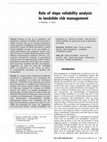
Bulletin of Engineering Geology and the Environment
Progress in the use of qualitative and quantitative methods of landslide risk assessment is brief... more Progress in the use of qualitative and quantitative methods of landslide risk assessment is briefly reviewed. The use of a hazard-consequence matrix approach is highlighted and attention is then restricted to aspects of hazard assessment in which formal reliability concepts can be used. Widely accepted geotechnical and geological models must form the basis of credible hazard assessments under different environmental conditions. However, conventional deterministic methods of geotechnical analysis need to be supplemented by studies within a probabilistic framework which takes into consideration parameter variability and other uncertainties. Suggestions are made for using the ''reliability index'' in preference to the ''factor of safety'' in comprehensive procedures for landslide risk management. Keywords Reliability index AE Factor of safety AE Hazard AE Risk management AE Landslides AE Probabilistic models Mots clés Indice de fiabilité AE Facteur de sécurité AE Aléa AE Gestion des risques AE Glissements de terrain AE Modèles probabilistes
Geological Society, London, Engineering Geology Special Publications
Shrink-swell 410, 465 Volcanoes 114, 624 Fissuring 596 Undermining 262 Contamination 293 Radon 554
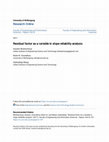
Bulletin of Engineering Geology and the Environment
In the past, residual factor R in strain-softening soil slopes has been included, either directly... more In the past, residual factor R in strain-softening soil slopes has been included, either directly or indirectly, as a deterministic variable in both deterministic and probabilistic studies. This paper discusses the uncertainties associated with R and outlines a systematic approach for the reliability analysis of a natural slope in which shear strength parameters and pore pressure ratio are random variables, each assumed with a lognormal probability distribution. For the residual factor R, seven probability distribution options under the generalized beta-distribution system are considered. Slope reliability is computed based on the first order reliability method (FORM) and validated against Monte-Carlo simulation (MCS). Results obtained from two illustrative examples indicate that the probability of failure, with R as one of six random variables, can be orders of magnitude higher than that based on five random variables with R considered as a deterministic parameter. The magnitude of influence of R as a random variable is, however, highly dependent on its probability distribution, the left-skewed triangular distribution having the most significant influence in both the examples. Results of sensitivity analyses reveal that, for almost all of its assumed probability distributions, R is the most dominant among the six random variables. Effects of variation of some of the statistical and correlation properties of the other random variables, viz. the shear strength parameters and the pore pressure ratio, on the results of reliability analyses are also studied.
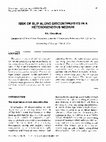
Mining Science and Technology
This paper is concerned with the methodology for the calculation of risk or probability of slip a... more This paper is concerned with the methodology for the calculation of risk or probability of slip along planar discontinuities within a rock mass. A risk model is presented in which both geometrical and shear strength parameters may be regarded as random variables. However, the paper focuses attention on the randomness of shear strength parameters. Adjacent discontinuities may be dissimilar in respect of the values of shear strength parameters. However, individual shear strength parameters may be correlated and, therefore, the safety margins against slip along individual discontinuities are also correlated. Thus, it is not sufficient to calculate the risk of failure along a discontinuity as an independent event. It is also important to calculate the conditional probability of failure along a discontinuity given that an adjacent discontinuity has slipped. The relevant equations and calculation procedures are outlined and typical results presented.

Reliability Engineering & System Safety
ABSTRACT This paper is concerned with the evaluation of reliability index for slope stability con... more ABSTRACT This paper is concerned with the evaluation of reliability index for slope stability considering the approximation of the relevant performance function on the basis of the well-known first-order second-moment approach. The performance function itself is derived on the basis of a valid mathematical or engineering model and this paper refers specifically to limit equilibrium slope stability models. Depending on the choice of model, the performance function may or may not be explicit. Moreover, the basic random variables may be considered either as uncorrelated or as correlated.Two well-known definitions of the reliability index and the results for slope stability problems based on these definitions are compared in this paper. A new procedure for the derivation of the so called ‘invariant’ reliability index, when the basic random variables are correlated, is presented. Moreover, an alternative procedure for an iterative evaluation of this reliability index is presented when the performance function is non-linear. For linear performance functions the two alternative definitions of the reliability index lead to precisely the same formulation. Several illustrative examples of slope stability are presented to demonstrate the influence on reliability index values based on both definitions of increasing (a) the expected value of the performance function, (b) the correlation coefficient between cohesion and angle of internal friction, and (c) the coefficient of variation of cohesion and angle of internal friction.Finally, a geometrical interpretation of the simple definition of reliability index is presented enabling the two definitions to be considered together on a single representation in the random variable space. This representation shows clearly how the two different definitions relate to each other.
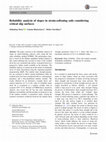
Innovative Infrastructure Solutions, 2016
The paper concerns to the reliability analysis of slopes in strain-softening cohesive soils, usin... more The paper concerns to the reliability analysis of slopes in strain-softening cohesive soils, using the first order reliability method (FORM). The performance function is based on the Bishop simplified method adapted to take strain-softening into account in terms of the residual factor R F over a potential slip surface, estimated based on a progressive failure model available in the literature. The reliability analysis is carried out on the surface of minimum factor of safety determined using the sequential quadratic programming (SQP). The random shear strength parameters are assumed to follow normal distribution while the residual factor has been considered both as a deterministic parameter and a beta-distributed random variable. The results obtained for an illustrative example shows substantial reduction (21 %) in the value of reliability index when R F is considered as a random variable with an assumed COV of 0.3. Results of FORM-based sensitivity analyses also reveal that R F has...
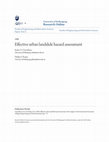
Landslide hazard assessment is a vitally important component of any strategy for the management o... more Landslide hazard assessment is a vitally important component of any strategy for the management of risk of instability in hilly areas. Within many urban areas, reactivation of landslides is an important component of risk. Yet, most qualitative approaches do not differentiate between the hazard of individual landslides. Two quantitative approaches are introduced in this paper both of which utilise GISbased accurate maps of geology and landslip as well as a landslide database. The first method is based on historical recurrence of individual landslides. The second method is based on monitoring of subsurface shear movements, and their relationships to rainfall. Both methods can provide reliable information on hazard. Hazard ranking based on the first method has been validated in the Greater Wollongong area of the State of New South Wales in Australia. This paper does not address the potential hazard associated with sites which are recognised to be stable with no known history of instability.
This paper is concerned with a description of the techniques for the development of digital maps ... more This paper is concerned with a description of the techniques for the development of digital maps of geology and slope instability. The validation of such maps by field inspection and checking is highlighted. These techniques have been used successfully for the suburbs of the northern Wollongong region of New South Wales. Such maps allow the flexibility of future modifications as additional and or more reliable data becomes available. These maps will facilitate decisions on the planning and management of land use. Currently, 295 cases of land instability have been documented within the study area. The maps are also expected to be useful for the development of reliable hazard and risk assessment procedures.
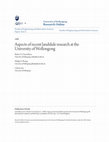
This paper introduces the issues which are of critical importance to landslide hazard and risk as... more This paper introduces the issues which are of critical importance to landslide hazard and risk assessment and management. These include understanding of probability and consequence, the separation of the role of sitedependent factors from that of influencing/triggering natural events and the factors influencing target levels of risk. The research completed at the University of Wollongong is then outlined. This includes the development of an observational approach based on monitoring of subsurface movements at individual sites and appropriate use of rainfall data in terms of the concept of annual rainfall percentage exceedance time (ARPET). Attention is then focused on current research including the development of a hazard-consequence matrix approach for risk assessment at individual sites. Another important research task concerns the development and assessment of magnitude-cumulative frequency relationships for landslides in the study area.
Journal of the Geotechnical Engineering Division, 1978
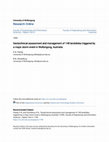
On the 17th August 1998 a severe rainfall event occurred over a widespread area of the City of Wo... more On the 17th August 1998 a severe rainfall event occurred over a widespread area of the City of Wollongong. During this storm, 1 person drowned and an estimated $50 to $100 million damage was caused to the City of Wollongong. Road access to the City was cut by raised water levels and debris flows covering and or scouring road and rail routes for up to 36 hours following this event. A geotechnical team of 3, including the first author, was organised at very short notice during the response phase of the emergency operations on the early morning of the 20th August by the Local Emergency Management Officer of the Wollongong City Council. This team was organised with a Commonwealth Bureau of Meteorology weather forecast in hand of a further deterioration of the weather conditions expected during the next few days. In the weeks after the storm event the team inspected 191 geotechnical problem sites. The team assisted the emergency services by visually inspecting reported cases of slope instability, whilst a separate team looked at flooding and hydrological problems. The geotechnical team also determined action plans for hazard and risk assessment that included referral of sites to relevant authorities, as appropriate. A Hazard-Consequence Matrix based Risk Assessment approach, in accordance with the AS/NZS 4360:1995 Risk Management Standard was adopted for the qualitative risk assessment work. A comprehensive database of site, visit, photograph and map information was collated for documentation and future reference.











Uploads
Papers by Robin Chowdhury